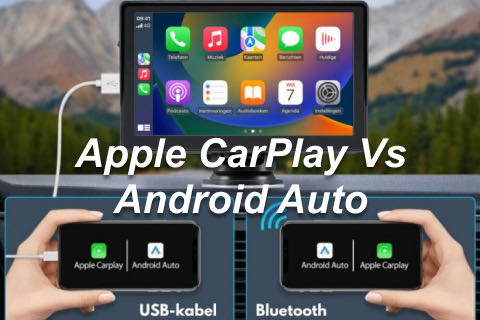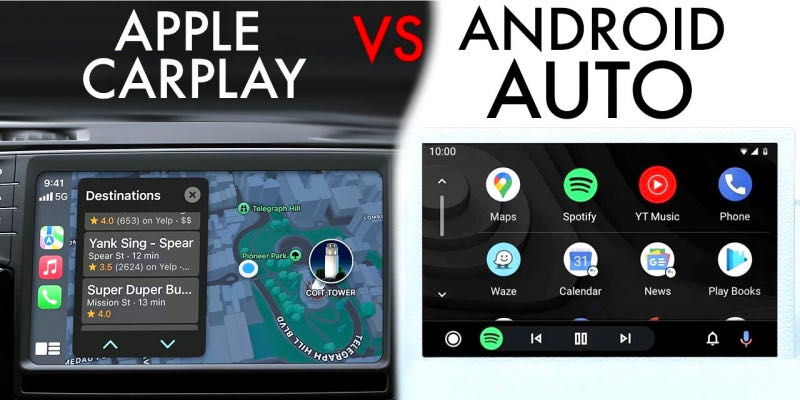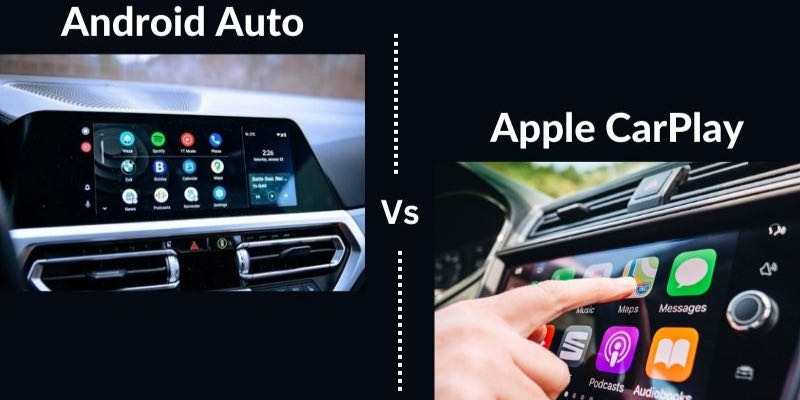
Apple CarPlay Vs Android Auto
In the contemporary automotive landscape, the integration of smartphones with our vehicles has become more than just a luxury—it's an expectation. Two giants, Apple and Android, have paved the way for a seamless connection between our phones and our cars. In this blog, we'll delve into the intricacies of Apple CarPlay and Android Auto, comparing their features, usability, and compatibility to help you decide which road to take for your in-car experience.
1. What Apple CarPlay can do?

Navigation: Apple Maps is integrated with Carplay auto radio, allowing you to get directions and real-time traffic updates. You can also use third-party navigation apps like Google Maps or Waze.
Music: You can access your music library, as well as apps like Spotify and Pandora, through Apple Carplay radio.
Messaging: You can send and receive text messages and make phone calls through CarPlay. You can use Siri to dictate messages or make calls hands-free.
Siri: You can use Siri to control your phone and access apps hands-free. You can ask Siri to play music, get directions, or send a message without taking your hands off the wheel.
Calendar: You can access your calendar through Apple CarPlay, allowing you to see upcoming appointments and events.
Podcasts: You can access your favorite podcasts through Apple CarPlay, as well as apps like Overcast and Pocket Casts.
Audiobooks: You can access your audiobooks through Apple CarPlay, as well as apps like Audible and Libby.
Weather: You can check the weather through Apple CarPlay, allowing you to see current conditions and forecasts.
News: You can access news apps like NPR and CNN through Apple CarPlay, allowing you to stay up-to-date on current events.
2. What exactly does Android Auto do?

Navigation: Google Maps is integrated with Android Auto, allowing you to get directions and real-time traffic updates. You can also use third-party navigation apps like Waze.
Music: You can access your music library, as well as apps like Spotify and Google Play Music, through radio Android Auto.
Messaging: You can send and receive text messages and make phone calls through Android Auto. You can use Google Assistant to dictate messages or make calls hands-free.
Google Assistant: You can use Google Assistant to control your phone and access apps hands-free. You can ask Google Assistant to play music, get directions, or send a message without taking your hands off the wheel.
Calendar: You can access your calendar through Android Auto, allowing you to see upcoming appointments and events.
Podcasts: You can access your favorite podcasts through Android Auto, as well as apps like Pocket Casts and Stitcher.
Audiobooks: You can access your audiobooks through Android Auto, as well as apps like Audible and Google Play Books.
Weather: You can check the weather through Android Auto, allowing you to see current conditions and forecasts.
News: You can access news apps like NPR and CNN through Android Auto, allowing you to stay up-to-date on current events.
Home Automation: If you have smart home devices that are compatible with Google Assistant, you can control them through Android Auto.
3.Apple Carplay vs Android Auto Pros and Cons
As smartphones become more important in our daily lives, their capabilities are increasingly integrated into our driving experience. Apple's CarPlay and Google's Android Auto are the two main bluetooth head units on the market today, allowing drivers to safely use their smartphones while driving. However, both systems have their pros and cons, and this blog will compare them.

(1) Advantages of Apple CarPlay:
Intuitive user interface: CarPlay’s user interface is simple, intuitive to operate, and consistent with the design style of IOS, which is a huge advantage for loyal users of Apple products.
Siri voice control: CarPlay's Siri voice control function is very powerful. Users can send messages, make calls, or select music through voice commands, which allows the driver to focus more on the road.
Privacy protection: Apple has always attached great importance to user privacy protection, and CarPlay will not collect users’ personal data for advertising or other commercial purposes.
(2) Cons of Apple CarPlay:
Compatibility limitations: CarPlay only works with iOS devices, which is a clear disadvantage for non-Apple users.
App restrictions: CarPlay has stricter restrictions on the apps that can be used than Android Auto, which may restrict users from using some of their favorite apps.
(3) Advantages of Android Auto:
Broad compatibility: Android Auto works on a variety of smartphones and vehicles, making it more flexible for different users.
Google Assistant: Android Auto integrates Google Assistant, an intelligent assistant that excels at information retrieval and real-time navigation.
Open application ecosystem: Android Auto’s support for third-party applications is more open, and users can enjoy more diverse services.
(4) Cons of Android Auto:
System Stability: Some users have reported that Android Auto may experience unstable connection issues on certain models or phones.
User interface differences: Because Android Auto adapts to multiple screens and devices, its user interface may not be as consistent as CarPlay.
In conclusion, choosing CarPlay or Android Auto largely depends on personal device preferences and usage habits. Apple users may prefer CarPlay for its seamless experience, while Android users may choose Android Auto for its compatibility and openness. Both systems are constantly being updated and improved to provide users with safer and more convenient driving assistance functions. Whichever we choose, the important thing is that they both enhance our driving experience and make us safer and more efficient on the road.
4.Android Auto vs Apple Carplay Sound Quality
When it comes to infotainment systems in our vehicles, Android Auto and Apple CarPlay have revolutionized how we integrate our digital lives with our driving experience. One of the most underrated aspects of this integration is sound quality. For audiophiles and casual listeners alike, the quality of music, podcasts, and even navigation prompts can significantly enhance the driving experience. In this blog, we'll compare the sound quality of Android Auto and Apple CarPlay, and see which system hits all the right notes.

(1) Tuning Into the Basics
Before diving into the nuances of sound quality, it's important to understand that both Android Auto and Apple CarPlay are not direct sources of car audio dvd player. Instead, they are conduits that transmit audio signals from your smartphone to your car's sound system. Therefore, the sound quality is influenced not only by the software but also by the hardware of both your smartphone and your car audio video system.
(2) Harmony and Hardware
The first factor in sound quality is the digital-to-analog converter (DAC) in your smartphone. This is the component that turns digital audio files into analog signals that your car's speakers can play. iPhones are known for having high-quality DACs, which is why even with a wired connection, the sound is crisp and clear. Most modern Android phones also have competent DACs, but there can be variability between manufacturers and models.
(3) The Connection: Wired vs. Wireless
Both platforms support wired and wireless connections, but the choice between USB and Bluetooth can affect sound quality. Wired connections tend to offer better fidelity because USB can transmit larger amounts of data without compression. Wireless connections via Bluetooth, while convenient, often compress audio data, which can degrade sound quality. However, with advancements in Bluetooth technology, such as aptX HD for Android, this gap is narrowing.
(4) Volume and Clarity: The Software's Role
Apple CarPlay and Android Auto both process audio signals in different ways. Apple CarPlay is known for its consistency in delivering balanced sound across different apps and services. Its integration with iOS means it can leverage Apple's expertise in audio processing to maintain a high standard of sound quality.
Android Auto, with its more open approach, might offer a slightly different sound experience depending on the app or service you're using. However, it also means users have more options to customize their audio settings within certain apps, potentially enhancing their listening experience if they're willing to tweak those settings.
(5) Equalization and Effects
The sound settings on your dvd car audio infotainment system also play a key role. Both CarPlay and Android Auto allow the car's native equalizer settings to affect the audio output. This means that regardless of whether you're an Android or Apple user, you can adjust bass, treble, and mid-tones to suit your preferences directly through your car's interface.
(6) App Ecosystem and Streaming Quality
The quality of audio streaming services is another variable. Both platforms support a variety of streaming apps, like Spotify, Apple Music, and Tidal. These services offer different levels of streaming quality, with some providing high-resolution audio options that can make a noticeable difference if your in-car system supports it.
(7) The Verdict: Is There a Clear Winner?
The truth is, the difference in sound quality between Android Auto and Apple CarPlay is often subtle and can be overshadowed by other factors like the quality of your in car audio system, your phone's hardware, and your personal sound preferences.
For iPhone users, Apple CarPlay may provide a more consistent and controlled audio experience, while Android Auto offers more customization for those who like to fine-tune their sound settings. Ultimately, the best way to judge is by listening to both systems in your own car, with your own phone, and with your preferred audio settings and content.
In the end, both Android Auto and Apple CarPlay offer high-quality audio experiences that can be optimized depending on your vehicle's sound system and your personal preferences. As technology advances, we can expect even higher fidelity and more features that cater to audiophiles on the road. For now, whether you're team Android or team Apple, rest assured that your next drive can be accompanied by a soundtrack that's not just background noise, but a high-quality audio experience.
5.Android Auto and Apple Carplay Infotainment System
The modern driver demands more than just a vehicle that can get from point A to point B. Today, the journey matters just as much as the destination, and this is where Android Auto and Apple CarPlay come into play. These infotainment systems have transformed car dashboards into extensions of our smartphones, offering connectivity, entertainment, and navigation with a touch of a screen or the sound of a voice. In this blog, we'll explore these two titans of in-car technology and how they're driving the future of automotive infotainment.

(1) The Dashboard Revolution
Gone are the days of fumbling with buttons and tuning dials. Android Auto and Apple CarPlay have streamlined the way we interact with our vehicles. With a user-friendly interface modeled after their smartphone counterparts, these systems have made it easier and safer to access music, maps, and messages on the go.
(2) Android Auto: The Open Road of Possibilities
Android Auto, Google's answer to the call for smart car integration, offers a familiar interface for Android users. It's designed to display information during the drive that is easy to understand at a glance, minimizing distractions and prioritizing safety. Features like Google Maps navigation, hands-free Google Assistant, and a host of third-party apps ensure that whether you're looking for that new café in town or need to send a quick message, it's all possible without taking your eyes off the road.
(3) Apple CarPlay: The Intuitive Journey
Apple CarPlay, on the other hand, brings the clean aesthetics and straightforward functionality of iOS to your vehicle's dashboard. With Siri at the helm, voice commands become second nature, allowing drivers to make calls, send texts, or choose the perfect playlist without lifting a finger. The system's integration with Apple's ecosystem means that your iPhone, iPad, and Mac are all synced up for a seamless experience from your driveway to your destination.
(4) Infotainment at a Glance
Both systems boast large, colorful icons and responsive car touch screens that make navigating their menus a breeze. The importance of this cannot be overstated – a driver's interaction with their touch screen infotainment system for car should be as quick and effortless as possible to maintain focus on the road.
(5) Customizable Consoles
Personalization is key in the world of infotainment. Android Auto and Apple CarPlay offer customizable interfaces that can be tailored to fit the driver's needs. Whether it's rearranging icons or choosing which apps to display, these systems ensure that the most vital functions are always within reach.
(6) Connectivity and Beyond
Connectivity is the core of both platforms. Android Auto and Apple CarPlay are designed to integrate seamlessly with your vehicle's native system. Whether you're connecting via USB or wirelessly, your infotainment system acts as a bridge between your car and your smartphone, providing a unified and intuitive interface.
(7) The App Universe
Both platforms offer an extensive array of apps, from Spotify to WhatsApp, allowing drivers to maintain the full breadth of their digital life on the go. This app integration means that drivers can listen to audiobooks, catch up on podcasts, or get real-time traffic updates all through their car's infotainment system.
(8) The Road Ahead
As technology accelerates, Android Auto and Apple CarPlay are not just keeping pace; they're driving innovation. With each update, they bring new features and improved interfaces that promise a more connected and enjoyable driving experience. Looking forward, we can expect these systems to integrate even more deeply with our vehicles, perhaps eventually taking over as the primary interface for all in-car controls.
In conclusion, android Auto and Apple CarPlay have set a new standard for vehicle infotainment systems. They've made it possible for drivers to stay connected, informed, and entertained without sacrificing attention to the road. As they continue to evolve, one thing is clear: the future of driving looks smarter, safer, and a whole lot more fun. Whether you're an Android devotee or an Apple enthusiast, your next drive can be as connected as the rest of your digital life. Welcome to the era of the infotainment system – where every journey is an experience, and the car is more than just a car; it's a mobile command center for the road ahead.
6.Can A Car Have Both Apple CarPlay and Android Auto
In the digital age, the automotive industry has witnessed a revolutionary convergence of technology and transportation. With the rise of infotainment systems like Apple CarPlay and Android Auto, car enthusiasts and tech aficionados alike are asking: Can a car have both? The answer is a resounding yes, and this blog delves into the harmonious relationship between these two systems within the modern vehicle's dashboard.

(1) The Crossroads of Compatibility
The first thing to understand is that Apple CarPlay and Android Auto are not mutually exclusive technologies. In fact, most car manufacturers have embraced the reality that drivers live in a diverse technological ecosystem and have designed their infotainment systems to be compatible with both platforms.
(2) Seamless Integration: A Tale of Two Systems
Imagine stepping into your vehicle with friends or family who have different smartphone preferences. Some are dedicated iPhone users, while others swear by their Android devices. The beauty of having both Apple CarPlay and Android Auto is the seamless transition between the two. The car's system detects the connected smartphone and launches the corresponding platform, ensuring that no matter the device, the infotainment experience remains uninterrupted.
(3) User-Friendly Design: No Driver Left Behind
Manufacturers have made it a priority to design infotainment systems that cater to all users. Whether you're an Apple aficionado or an Android advocate, the inclusion of both CarPlay and Android Auto ensures that you won't miss out on key features like navigation, music streaming, or hands-free communication.
(4) The Technical Truce: How It Works
When a smartphone is connected to the car via USB or wirelessly, the infotainment system recognizes the device's operating system and presents the appropriate interface. This means that drivers don't have to choose between CarPlay and Android Auto when purchasing a car; they can alternate between the two as needed, depending on which smartphone they bring into the vehicle.
(5) The Best of Both Worlds
Having access to both platforms is like having two different driving experiences in one car. Apple CarPlay offers the simplicity and familiarity of iOS, while Android Auto presents the customizable and Google-centric environment many users love. This dual offering caters to a broader audience and ensures that no matter your smartphone allegiance, your car is ready to serve your needs.
(6) Future-Proofing the Drive
As technology continues to evolve, having both CarPlay and Android Auto can be seen as a form of future-proofing your vehicle. With software updates and new apps being developed constantly, drivers can rest assured that their stereo head unit will stay up to date, regardless of which smartphone they're using.
In conclusion, the question of whether a car can have both Apple CarPlay and Android Auto is not just a matter of possibility but one of practicality. In today's interconnected world, the ability to cater to both iOS and Android users is not just a convenience; it's a necessity. Car manufacturers have recognized this and are offering systems that provide the flexibility and inclusivity that modern drivers require.
The road ahead is clear: the coexistence of Apple CarPlay and Android Auto in your car is not only possible but also emblematic of the automotive industry's commitment to innovation and customer satisfaction. As we navigate the highways of progress, the fusion of these infotainment giants within our vehicles assures us that, no matter our device preference, the journey will be a connected and enjoyable one.
7. Conclusion
As the automotive and tech industries continue to innovate, we can expect both Apple CarPlay and Android Auto to advance in their capabilities and offerings. The competition between these two platforms benefits us all, pushing forward a safer, more connected, and enjoyable in-car experience. Whether you're an Apple aficionado or an Android enthusiast, the road ahead looks promising.
